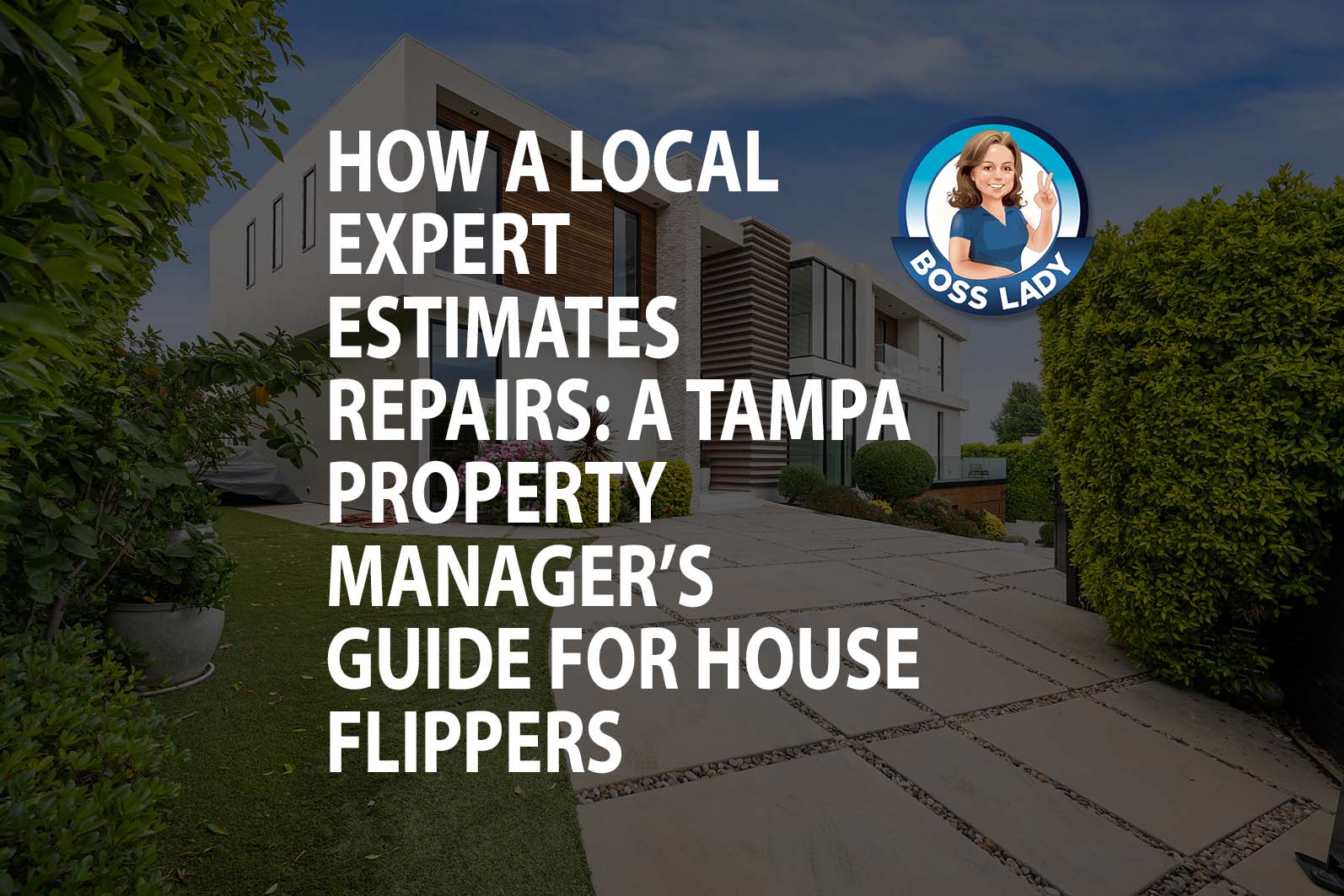If you have ever messed up while trying to estimate the repairs needed on a property, you need to listen up. This guide can save you time and money.
Flipping houses in Tampa can be a lucrative endeavor, but success hinges on a well-executed repair strategy. Whether you’re a seasoned investor or new to house flipping, understanding how to estimate repairs effectively is crucial. A local property manager, well-versed in Tampa’s real estate and construction markets, can provide invaluable guidance. This article outlines how a local expert can help estimate repairs through a systematic approach: inspecting the property, creating a checklist, choosing reputable contractors, analyzing recent sales, and determining a budget that maximizes ROI.
I’m Laura, the Boss Lady. Let’s get started.
Inspect The Property To Identify The Areas That Require Immediate Attention
The first step in estimating the repairs needed for a property is conducting a thorough inspection.
But what are you looking for?
Well, I like to prioritize repairs. What needs to be fixed immediately? What has to get done but is not urgent? What can wait?
Making a list of every repair needed and prioritizing each item on the list makes it far easier to ultimately hire the right contractor for each specific project – more on that later.
Here is a basic list:
1. Initial Property Walkthrough
I like to take my initial walkthrough of the property to note all visible signs of wear and tear, any noticeable structural issues, code violations, and any other issues that may require immediate attention.
Some common areas of focus include:
– Roof and Gutters: Inspect for leaks, missing shingles, or damage.
– Foundation and Structure: Look for cracks in walls, uneven floors, or signs of settling.
– Plumbing: Make sure all faucets work, check under sinks for leaks, make sure all toilets flush properly, and make sure hot water gets hot.
– Electrical Systems: Inspect the panel and all sub panels, check for outdated wiring, malfunctioning outlets, and any signs of non-standard wiring.
– HVAC Systems: Ensure heating and cooling systems are operational and up-to-date, check ductwork for any tears or visible damage.
– Windows and Doors: Assess for drafts, broken seals, or damaged frames.
– Any signs of pests.
– Any signs of mold.
2. Specialized Inspections
My initial walkthrough is not intended to replace any standard, required inspections. Any areas noted above may require further inspection.
These can include:
– Pest Inspection: Identifies potential pest infestations, such as termites or rodents.
– Mold Inspection: Detects hidden mold issues that could affect the property’s value and safety.
– Asbestos Inspection: Determines if asbestos is present, which requires specialized removal procedures.
3. Prioritization
Go through your entire list. Prioritize it. All concerns that require immediate attention are moved to the top of the list.
Create A Checklist With Estimated Costs
You have a prioritized list. The next step is to create a detailed checklist of repairs and estimate their costs. This process involves:
1. The Repair Checklist
The checklist should categorize repairs into various types, such as:
– Structural Repairs: Foundation work, roof replacement.
– Systems Upgrades: Electrical rewiring, plumbing updates.
– Cosmetic Improvements: Painting, flooring, landscaping.
2. Cost Estimation
Assign an estimated cost to each checllist item. This can be done by:
– Researching Material Costs: Determine the cost of materials needed for each repair.
– Labor Costs: Estimate the cost of labor based on local rates and the complexity of the work.
– Contingency Fund: Include a contingency amount (typically 10-20% of the total repair costs) for unexpected expenses.
A local expert’s knowledge of Tampa’s market allows them to provide accurate cost estimates, leveraging their connections with suppliers and contractors to get competitive prices.
Choose Reputable and Specialized Contractors
The priority is to stay on budget! Estimates for repairs are not accurate, that’s why they are estimates. ROI begins and ends with accurate costing. Most in the know will tell you that profits are made early. Your profits will depend on your ability to properly estimate repair costs and to get the repairs done for a fair price. Controlling these costs is the difference between success and failure.
No one wants to lose money. Almost anyone that has ever flipped a house and lost money can trace their losses back to going over budget – an overlooked costs, overspending, failing to track expenditures, and more.
So be thorough, and be honest. Find the right contractor to get the job done right the first time. Easier said than done, but it can be done.
And one last thing, not all contractors are right for all jobs. There’s nothing wrong with hiring a specialist. If that’s what it takes, then that is way you go. Get the job done right the first time.
Here are a few general tips to help you choose the right contractor:
1. Check Research and Referrals
Contractors who have a proven track record in Tampa are at the top of the list. We face unique challenges in Tampa Bay – from mold to termites, our climate poses problems that outside contractors might not have experience with.
I take referrals into account, but I’m careful to consider the source and I only consider a referral for specific needs. In other words, if I get a referral for an electrician, I consider that contractor for that specific job.
From there, we get to selecting the right contractor for each job.
2. Vetting Contractors
The vetting process includes:
– Checking Licenses and Insurance: Ensure that contractors are licensed and carry adequate insurance.
– Reviewing Portfolios: Examine their past projects to assess the quality of work.
– Reading Reviews: Look for customer reviews and ratings on platforms like Google, Yelp, or Angie’s List.
3. Obtaining Multiple Quotes
Getting quotes from several contractors helps in comparing costs and understanding the scope of work. The property manager can assist in negotiating terms and ensuring that quotes are detailed and comprehensive.
No matter how good or bad a quote is, I like to get 3 quotes for any project whenever possible.
These are my tips for contractors. Also, go with your gut.
Analyze Recent Sales Near The Property To Understand The Market Value
Understanding the market value of similar properties in the area is essential for determining which repairs will lead to the best ROI.
Here are a few tips:
1. Comparative Market Analysis (CMA)
A CMA involves analyzing recent sales of comparable properties (comps) in the neighborhood. Look at:
– Sale Prices: The prices at which similar properties recently sold.
– Condition of Comps: The condition and features of these properties.
– Market Trends: Current trends in the local real estate market.
2. Adjusting Repair Priorities
By understanding the market value of similar properties, you can adjust (as needed) the priority for your repairs.
Generally speaking, the order of repair priority is: kitchen, bathroom(s), living room, bedrooms.
Depending on the area where the property is question is, and what you find, you may decide to change your priorities.
Calculating Potential ROI
Again, this is an estimate. The more experience you have in estimating ROI, the better you should be at this.
To calculate, I consider:
– Repair Costs vs. Increased Value: Estimate how each repair will impact the property’s value.
– Profit Margin: Calculate the potential profit margin based on the expected sale price and repair costs.
– Budget Allocation
I want to reiterate that the goal is the highest possible ROI.
To do this, I always attempt to allocate the budget based on repair priorities. I also always focus on high-impact areas that will significantly enhance the property’s appeal and value. For example:
– Major Renovations: Allocate more budget to critical renovations that improve functionality and aesthetics.
– Minor Repairs: Spend less on minor repairs or cosmetic updates if they don’t significantly affect the property’s market value.
To stay on budget throughout the repair process, monitor expenses to ensure they stay within budget. A local property manager can provide oversight and adjust the budget as necessary to accommodate any changes.
In Closing
Estimating repairs effectively is key to successful house flipping in Tampa. By following the systematic approach outlined—inspecting the property, creating a detailed checklist, choosing reputable contractors, analyzing market data, and determining a strategic budget—house flippers can make informed decisions that lead to profitable outcomes. Leveraging the expertise of a local property manager ensures that you have the right guidance to navigate the complexities of property repairs and achieve the highest possible return on investment.


